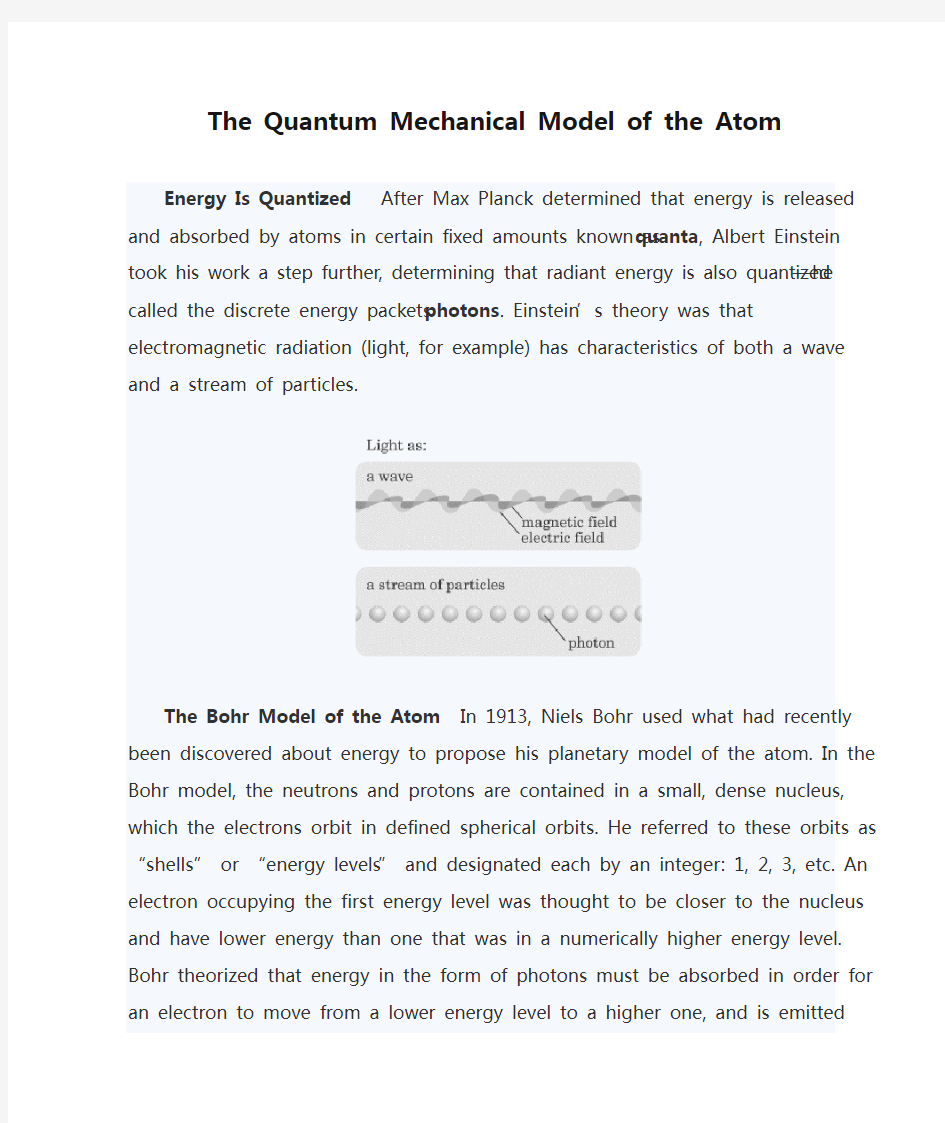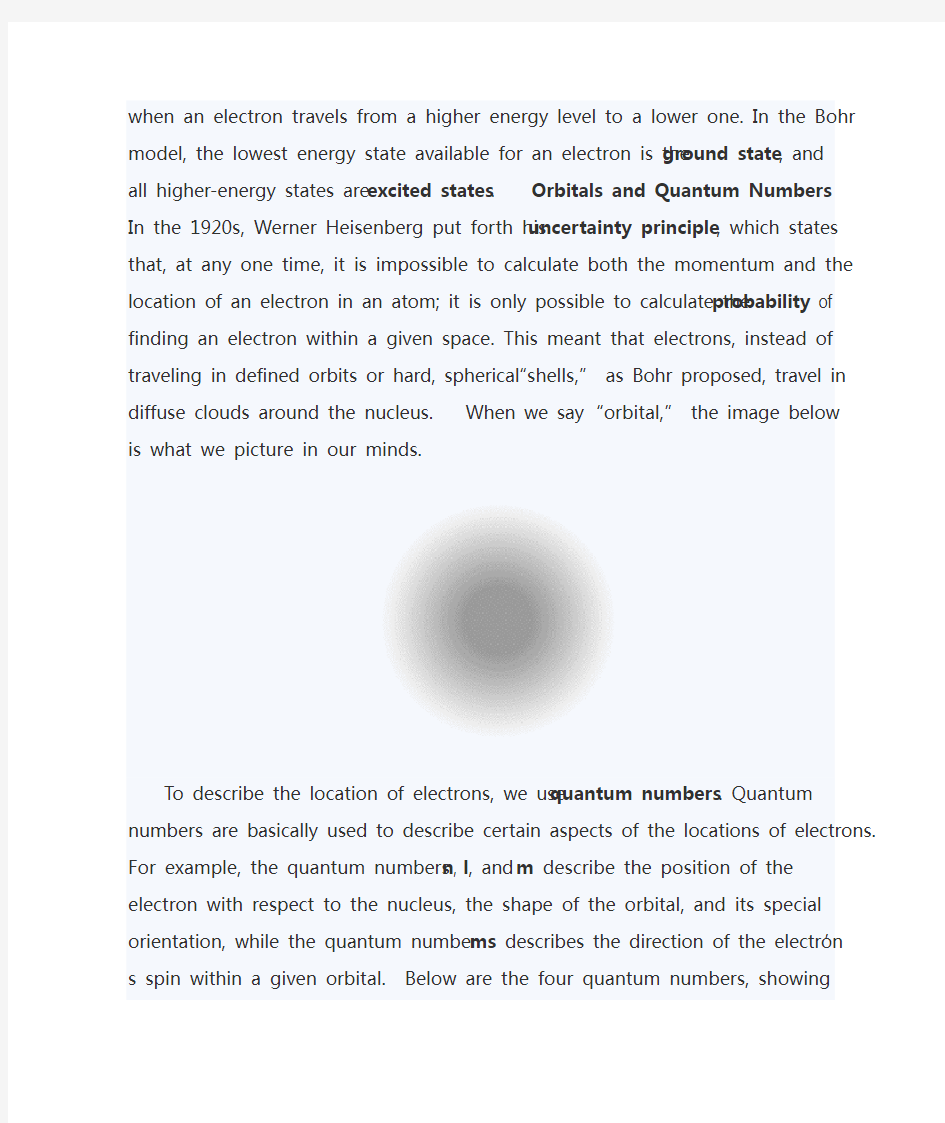The Quantum Mechanical Model of the Atom 原子的量子力学模型


The Quantum Mechanical Model of the Atom
Energy Is Quantized After Max Planck determined that energy is released and absorbed by atoms in certain fixed amounts known as quanta, Albert Einstein took his work a step further, determining that radiant energy is also quantized—he called the discrete energy packets photons. Einstein’s theory was that electromagnetic radiation (light, for example) has characteristics of both a wave and a stream of particles.
The Bohr Model of the Atom In 1913, Niels Bohr used what had recently been discovered about energy to propose his planetary model of the atom. In the Bohr model, the neutrons and protons are contained in a small, dense nucleus, which the electrons orbit in defined spherical orbits. He referred to these orbits as “shells” or “energy levels” and designated each by an integer: 1, 2, 3, etc. An electron occupying the first energy level was thought to be closer to the nucleus and have lower energy than one that was in a numerically higher energy level. Bohr theorized that energy in the form of photons must be absorbed in order for an electron to move from a lower energy level to a higher one, and is emitted when an electron travels from a higher energy level to a lower one. In the Bohr model, the lowest energy state available for an electron is the ground state, and all higher-energy states are excited states. Orbitals and Quantum Numbers In the 1920s, Werner Heisenberg put forth his uncertainty principle, which states that, at any one time, it is impossible to calculate both the momentum and the location of an electron in an atom; it is only possible to calculate the probability of finding an electron within a given space. This meant that electrons, instead of traveling in defined orbits or hard, spherical “shells,” as Bohr proposed, travel in diffuse clouds around the nucleus. When we say “orbital,” the image below is what we picture in our minds.
To describe the location of electrons, we use quantum numbers. Quantum numbers are basically used to describe certain aspects of the locations of electrons. For example, the quantum numbers n, l, and m describe the position of the electron with respect to the nucleus, the shape of the orbital, and its special orientation, while the quantum number ms describes the direction of the electron’s spin within a given orbital. Below are the four quantum numbers, showing how they are depicted and what aspects of electrons they describe. Principal quantum number (n) Has positive values of 1, 2, 3, etc. As n increases, the orbital becomes larger—this means that the electron has a higher energy level and is less tightly bound to the nucleus.
Second quantum number or azimuthal quantum number (l ) Has values from 0 to n – 1. This defines the shape of the orbital, and the value of l is designated by the letters s, p, d, and f, which correspond to values for l of 0, 1, 2, and 3. In other words, if the value of l is 0, it is expressed as s; if l = 1 = p, l = 2 = d, and l = 3 = f.
Magnetic quantum number (m) Determines the orientation of the orbital in space relative to the other orbitals in the atom. This quantum number has values from -l through 0 to +l.
Spin quantum number (ms) Specifies the value for the spin and is either +1/2 or -1/2. No more than two electrons can occupy any one orbital. In order for two electrons to occupy the same orbital, they must have opposite spins.
Orbitals that have the same principal quantum number, n, are part of the same electron shell. For example, orbitals that have n = 2 are said to be in the second shell. When orbitals have the same n and l, they are in the same subshell; so orbitals that have n = 2 and l = 3 are said to be 2f orbitals, in the 2f subshell. Finally, you should keep in mind that according to the Pauli exclusion principle, no two electrons in an atom can have the same set of four quantum numbers. This means no atomic orbital can contain more than two electrons, and if the orbital does contain two electrons, they must be of opposite spin.
